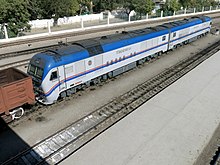Türkmendemirýollary
 Turkmen Railways' diesel locomotive CKD9A of Chinese origin | |
| Overview | |
|---|---|
| Locale | Turkmenistan |
| Dates of operation | 1991– |
| Predecessor | Central Asian Rail Line (USSR) |
| Technical | |
| Track gauge | 1,520 mm (4 ft 11+27⁄32 in) |
| Length | 4,980 km (3,090 mi) |
| Other | |
| Website | turkmendemiryollary |
 | |
Native name | "Demirýollary" AGPJ |
|---|---|
| Type | Government owned |
| Industry | Railways |
| Predecessor | Türkmendemirýollary agentligi |
| Founded | 5 February 2020 |
| Headquarters | Ashgabat , Turkmenistan |
Area served | Turkmenistan |
| Services | Rail transport, Cargo |
| TMT 1.626 billion (2018)[1] | |
| TMT 280 million (2018)[1] | |
| Owner | Turkmen Government |
Number of employees | ~15,000 (2020)[1] |
| Website | www |
Demirýollary AGPJ ("Railways open joint-stock company") is the state-owned operator of railways in Turkmenistan.[2] The company operates on 4,980 km (3,090 mi) of railways (37th in the world) and maintains over 345 railway stations throughout the country. The company belongs to the and is subordinate to the Railways Agency of Turkmenistan.[3] It is headquartered in Ashgabat. While the rail system itself belongs to the railways agency, the Turkmen Railways company owns the locomotive and railcar depots, rail stations, construction and maintenance units, communications and power supply services, and two hotels in Awaza, the Kerwen and Türkmenbaşy.[2]
History[]
Russian Empire[]
In September 1880, the first section of the railway was built from the eastern coast of the Caspian Sea to . In October 1881, rails were laid to the village of Kyzyl-Arvat (today's Serdar). Construction of the second section of the railway continued in 1885 and 1886 to large settlements of Turkmenistan: Geok Tepe, Ashgabat, Tejen, Mary, and Chardzhou (today's Türkmenabat, ending at the Amu Darya.[4]
At the end of 1887, a wooden bridge with a length of more than 2 km was built across the Amu Darya, which allowed construction of the third section of the railroad to begin. In 1888, the railway continued to Samarkand and in 1898 brought to Tashkent. Between 1894 and 1895, the Krasnovodsk (today's Turkmenbashy) section of the railroad was completed. Thus, the Trans-Caspian Railway, which played an important role in the development of the economy of Central Asia, including pre-revolutionary Turkmenistan, begins from the harbor of the Caspian Sea, Krasnovodsk Bay (today's Turkmenbashy Bay). The route from Krasnovodsk to Tashkent was called the Central Asian Railway.[4]
In 1901, the wooden bridge over the Amu Darya was destroyed by flood waters. It was replaced with a steel bridge built on stone supports.[4]
Soviet Union[]
In 1922, on the instructions of Vladimir Lenin, work began on the design of Soviet diesel locomotives for operation on waterless sections of Central Asia. In 1931, the Krasnovodsk-Chardzhou railway was switched to diesel traction. In 1955, all railway traffic in the Turkmen SSR was completely converted to diesel traction.[4]
A very important role was played by rail during the Second World War. During the battles near Stalingrad and the Caucasus (from August 1942 to February 1943), the Krasnovodsk port and Ashgabat railway station became the only transport arteries connecting Baku, Transcaucasia and the Black Sea with the whole country. They ensured the transfer of the army, a huge flow of military equipment and equipment to the North Caucasian and Transcaucasian fronts. For the selfless work of the railway workers of the Turkmen SSR, the Red Banner of the People's Commissariat of Railways of the USSR was repeatedly awarded.[4]
In the post-war period, improvement of the railway network infrastructure continued, increasing its carrying capacity. At almost all stations and crossings, passenger buildings, platforms and canopies were constructed. Air conditioned railcars were also commissioned, improving passenger comfort. Turkmen railways were among the first in the USSR to introduce diesel traction. In the early 1980s, the Mary-Kushka line was extended to the Afghan village of Torghundi.[4]
Independent Turkmenistan[]

Türkmendemirýollary was formed after the dissolution of the Soviet Union, as one of the heirs of Soviet Railways. The railway's most important station is Ashgabat railway station, the central station of the capital. After the collapse of the USSR, the construction of new lines again intensified, forced by the fact that the previous routes were interrupted by sections that became part of the and therefore crossed international boundaries. During the period after the collapse of the USSR, a number of new trunk lines were opened in Turkmenistan: Takhiatash (Uzbekistan)-Kunya-Urgench-Saparmyrat Türkmenbaşy adyndaky, Türkmenabat-Kerki-Kerkiçi, Tejen-Sarakhs (Iran), Ashgabat-Daşoguz, which made it possible to connect disparate sections of the railway network into a unified whole.
In 2017, construction was completed of a new rail bridge over the Amu Darya, replacing a bridge built in 1905.[5]
On 29 January 2019 the Ministry of Railways was downgraded to agency status, renamed the Turkmen Railways Agency (Turkmen: Türkmendemirýollary agentligi), and subordinated to the reorganized Ministry of Industry and Communications (which subsequently was again reorganized into the Ministry of Industry and Construction).[6] The open joint-stock company "Demirýollary" was formed as a commercial subsidiary of the Turkmen Railways Agency on 5 February 2020.[2]
In order to prevent infectious diseases, the movement of passenger trains in Turmkenistan was suspended on July 16, 2020. In the spring of 2021, passenger traffic was fully restored.[7][8] Passengers must have a COVID-19 negative test certificate issued no earlier than 72 hours before travel. Before boarding the train, passengers will have their temperature measured, oxolinic ointment will be applied to the nasal mucosa, and their hands will be treated with a disinfecting solution. The guides and representatives of the traffic police are obliged to monitor the observance of a distance of at least one meter, which must be adhered to by passengers, as well as the wearing of masks. Coupe tickets will only be available for 2 seats instead of 4. Conductors are obliged to disinfect the cars 6 hours before the train departs, after arriving at the destination and every 3-4 hours during the movement of trains.[9]
Activities[]
The main activities of Turkmen Railways involve freight and passenger traffic. The company annually serves almost 6 million passengers. The passenger department employs 5,000 specialists[10] out of a total staff profile of about 15,000.[1]
Sale of railway passenger tickets is carried out also via the Internet and a mobile application for Android and iOS.[11] The online ticketing service in Turkmenistan was launched on June 1, 2019.
Rolling stock[]
The Asian Development Bank reported in 2021,
In 2019, [Turkmen Railway Agency] had a rolling stock fleet of 119 diesel locomotives, 10,056 freight wagons, and 425 passenger cars. The majority of locomotives and all the passenger cars were purchased from the PRC (25 CKD9A-series passenger locomotives and 83 CKD9C-series freight locomotives). The freight wagon fleet included 2,849 tanker wagons, 1,738 gondola wagons, 1,637 platform wagons, 1,358 closed hopper wagons, 1,143 box wagons and 654 refrigerated wagons.... In 2019, 6,607 wagons (65% of the fleet) [were] at least 30 years old, with many of these wagons having exceeded their normal economic life and in need of replacement.[1]
In 2013, 154 passenger coaches were ordered from CSR;[12] CSR had previously supplied locomotives.[13]
Railways projects[]
First link to Iran[]
In 1996, the Mashhad–Sarakhs extension connected Iran to Turkmenistan, as part of the Silk Road railway for linking the landlocked Central Asian countries to the Persian Gulf. Railways in former states of the Soviet Union use 1,520 mm (4 ft 11+27⁄32 in) Russian gauge, and thus the Iranian Railways maintain break-of-gauge services at borders with Azerbaijan and Turkmenistan, in addition to short wide-track rail segments to the border crossings.
Kazakhstan-Turkmenistan-Iran railway (part of the North-South Transport Corridor)[]
Türkmendemirýollary participates in the rail project to link China and Southeast Asia to Europe over a length of 3,900 kilometres (2,400 mi) via the North-South Transport Corridor, which connects Kazakhstan to Iran via Turkmenistan using the Russian rail gauge. Iran is linked to Turkey and Europe's standard-gauge system. In December 2014 the rail line linking Iran to Kazakhstan via Turkmenistan was opened, creating the first direct rail link between Iran and China. Upon completion of the Marmaray rail project, direct rail transport between China and Europe while avoiding Russia will be possible.[14][15]
Afghanistan–Turkmenistan rail service[]
A 10-kilometer long line extends from Serhetabat in Turkmenistan to Torghundi in Afghanistan.[16] An upgrade of this 1960s-vintage Soviet-built line, using Russian gauge, began in 2007.[17] In April 2016, an agreement was reached for a technical feasibility study for a proposal to extend this line approximately 100 km to Herat,[18] where it could connect to the standard-gauge line to Khaf, Iran that is being built. In accordance with earlier decisions, the line is likely to be standard gauge, with break of gauge at Torghundi. In April 2018 the Turkmen government decided to build a railway from Galkynysh Gas Field in the direction of Afghanistan, towards Torghundi.[19][20]
Another rail line was opened farther east in November 2016, connecting Aqina in Faryab province via Ymamnazar with Kerki in Turkmenistan.[21] A planned 58 kilometres (36 mi) extension to Andkhoy has been proposed.[22] It is planned to become part of a rail corridor through northern Afghanistan, connecting it via Sheberghan to Mazar-i Sharif and on to the border with Tajikistan,[23] although it is unclear when this will happen.[24]
Railway links with adjacent countries[]
- Kazakhstan – same gauge (former Soviet Union railway system) – new rail link opened in 2013.
 Iran-open-break-of-gauge.1,520 mm (4 ft 11+27⁄32 in).
Iran-open-break-of-gauge.1,520 mm (4 ft 11+27⁄32 in).
Headquarters[]
Türkmenistan, Aşgabat ş., Türkmenbaşy şaýoly, jaý 7[25]
See also[]
- Railways Agency of Turkmenistan
- Rail transport in Turkmenistan
- Transport in Turkmenistan
- Trans-Karakum Railway
- Trans-Caspian railway
- North-South Transnational Railway Corridor
References[]
- ^ Jump up to: a b c d e "RAILWAY SECTOR ASSESSMENT FOR TURKMENISTAN" (PDF). Asian Development Bank. March 2021.
- ^ Jump up to: a b c "Агентство железнодорожных путей Туркменистана создало своё акционерное подразделение" (in Russian). Turkmenportal. 5 February 2020.
- ^ New Ministry of Industry and Construction Operations of Turkmenistan
- ^ Jump up to: a b c d e f "Транспорт / Железнодорожный транспорт" [Transport / Rail transport]. Туркменская ССР (in Russian). Chuvash Obkom CPSU. 1984. pp. 235–237.
- ^ "К открытию новых мостов Туркменабат-Фараб приурочен выход в свет специального иллюстрированного издания" (in Russian). «Туркменистан: золотой век». March 6, 2017.
- ^ "В Туркменистане создано новое министерство промышленности и коммуникации" (in Russian). Turkmenportal. 29 January 2019.
- ^ [1]
- ^ [2]
- ^ Введены новые правила проезда на железнодорожном транспорте в Туркменистане
- ^ О нас
- ^ В Туркменистане возобновлена услуга онлайн-продажи железнодорожных билетов
- ^ "Pakistan Railways orders 50 locomotives". Railway Gazette International. Retrieved 10 June 2013.
- ^ "World rolling stock market April 2013". Railway Gazette International. Retrieved 10 June 2013.
- ^ "Archived copy". Archived from the original on 14 August 2019. Retrieved 4 December 2014.CS1 maint: archived copy as title (link)
- ^ Kazakhstan-Turkmenistan-Iran Railway to Open Today, by Onur Uysal, http://railturkey.org/2014/12/03/kazakhstan-turkmenistan-iran-railway/ Archived 5 December 2014 at the Wayback Machine
- ^ Kakar, Javed Hamim (December 2017). "Construction of Turkmen-Afghan railroad begins". Pajhwok Afghan News. Retrieved 1 December 2017.
- ^ "Afghan rebuild underway". Railway Gazette International. 2007-07-12.
- ^ "Herat railway feasibility study contract signed". Railway Gazette. 18 April 2016.
- ^ https://www.azernews.az/region/141734.html
- ^ http://orient.tm/en/2018/04/12/6314.html
- ^ Salehai, Zarghona (28 November 2016). "Afghan-Turkmenistan railroad inaugurated". Pajhwok Afghan News. Retrieved 17 January 2017.
- ^ Hejaab, Aslam (31 October 2016). "Work Begins On Aqina-Andkhoy Railway". ariananews.af. Retrieved 17 January 2017.
- ^ Grantham, Andrew (31 October 2016). "TAT Railway". Railways of Afghanistan. Retrieved 19 January 2017.
- ^ https://www.railwaygazette.com/news/news/asia/single-view/view/afghan-railway-terminal-expansion-mou-signed.html
- ^ Demirýollary website
External links[]
- Rail transport in Turkmenistan
- Government-owned companies of Turkmenistan
- Railway companies of Turkmenistan
- Companies based in Ashgabat